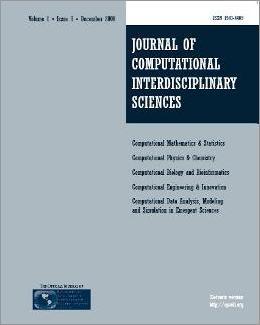
Editorial Office:
Management:
R. S. Oyarzabal
Technical Support:
D. H. Diaz
M. A. Gomez
W. Abrahão
G. Oliveira
Publisher by Knobook Pub


Editorial Office:
Management:
R. S. Oyarzabal
Technical Support:
D. H. Diaz
M. A. Gomez
W. Abrahão
G. Oliveira
Publisher by Knobook Pub
doi: 10.6062/jcis.2011.02.02.0036(Free PDF)
Tereza S.N. Pinto and Joaquim E.R. Costa
The solar magnetic field at coronal level is responsible for phenomena such as solar flares and coronal mass ejections. It is thus of interest to investigate the topological features that create the conditions for these events to occur. At the corona, the magnetic field is considered to be a force free field: r x EB = a EB. If a is a constant the force free field is linear and the differential equation has known solutions, such as the Fourier transform solution [1]. The boundary conditions are given by magnetograms, maps of the magnetic field at photospheric level. The magnetograms are produced from measurements of the Stokes parameters in spectral lines and application of inversion methods to derive the three components of the magnetic field. Apart from intrinsic issues (e.g. Zeeman saturation effect), the production of these maps must deal with other issues, such as noise and the instrument spectral and spatial resolution, and assumptions in the inversion method. We investigate what are the consequences for the extrapolated magnetic field due to boundary conditions determined from different sets of magnetograms. We aim to estimate the inaccuracies induced by the inversion codes in our method of extrapolation, comparing extrapolations from sets of data of two instruments: the Michelson Doppler Imager (MDI) on board SOHO observatory and the Spectro-Polarimeter (SP) of the Solar Optical Telescope (SOT) on board Hinode spacecraft. Thus, we evaluate the correlations and compare the topological features of the MDI and SP-SOT extrapolations.
computational physics, solar physics, force free fields, inversion methods.
[1] NAKAGAWA Y & RAADU MA. 1972. On pratical representation of magnetic field. Solar Physics, v. 1, 25: 127-135.
[2] SCHERRER PH et al. 1995. The solar oscillations investigation - Michelson Doppler Imager. Solar Physics, v. 1, 162: 129-188.
[3] TSUNETA S et al. 1995. The Solar Optical Telescope for the Hinode Mission: An Overview. Solar Physics, v. 2, 249: 167-196.
[4] http://www.csac.hao.ucar.edu/csac/nextGeneration.jsp, last access: 2010-08-19.
[5] BENTLEY RD & FREELAND SL. 1998. SOLARSOFT: an analysis environment for solar physics, Crossroads for European Solar and Heliospheric Physics. Recent Achievements and Future Mission Possibilities. ESA Special Publication, 417: 225-228.
[6] http://soi.stanford.edu/magnetic/Lev1.8/, last access: 2010-09- 19.
[7] SAKURAI T. 1989. Computational modeling of magnetic fields in solar active regions. Space Science Reviews, 51: 11-48.
[8] WANG D, ZHANG M, LI H & ZHANG HQ. 2009. A cross-comparison of cotemporal magnetograms obtained with MDI/SOHO and SP/Hinode. Solar Physics, v. 1, 260: 233-244.
[9] SILVA CW, COSTA JER & ROSA RR. 2010. A computational approach for the recognition of the magnetic field lines on Solar Corona, 1st Conference on Computational Interdisciplinary Sciences, São José dos Campos.